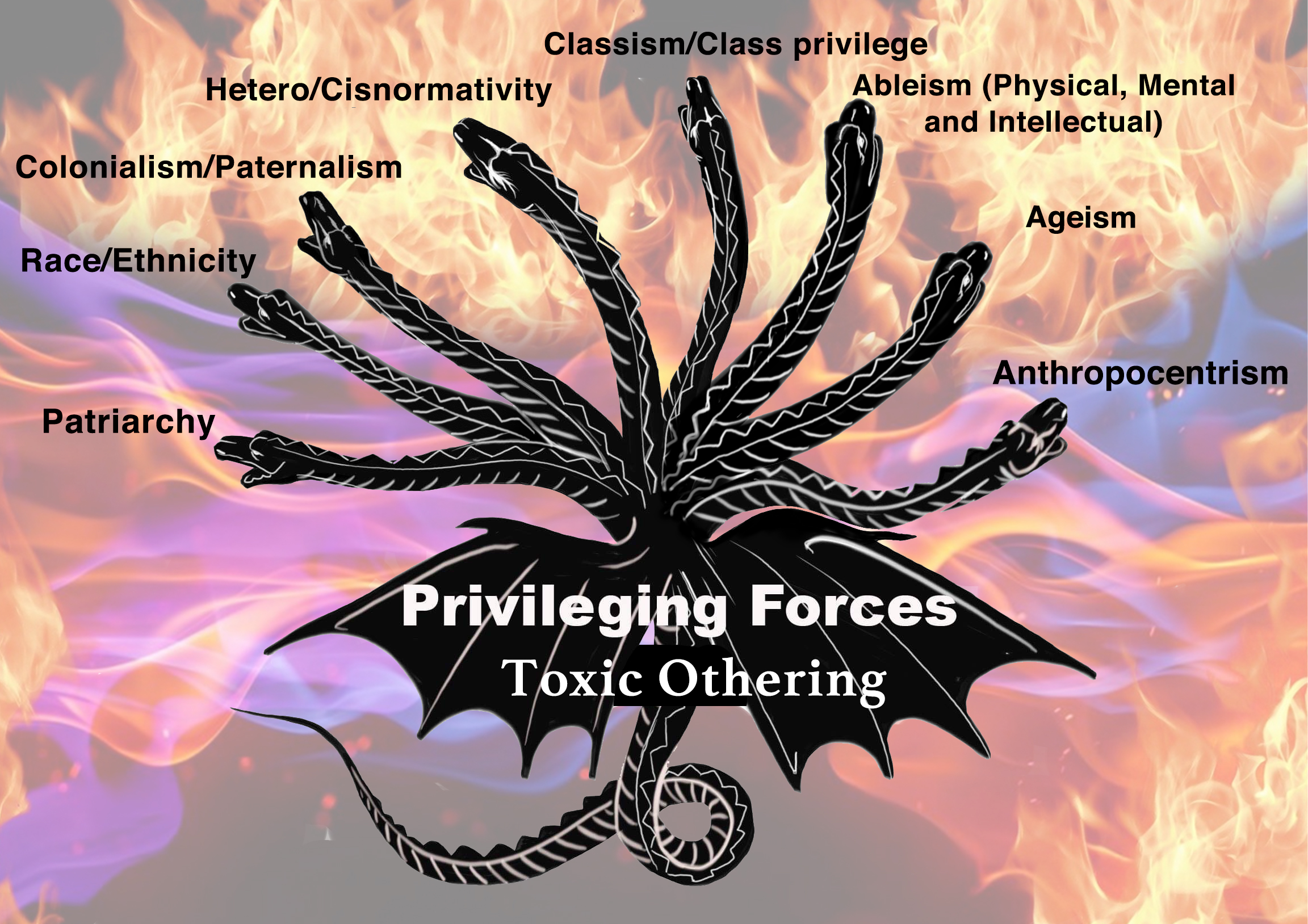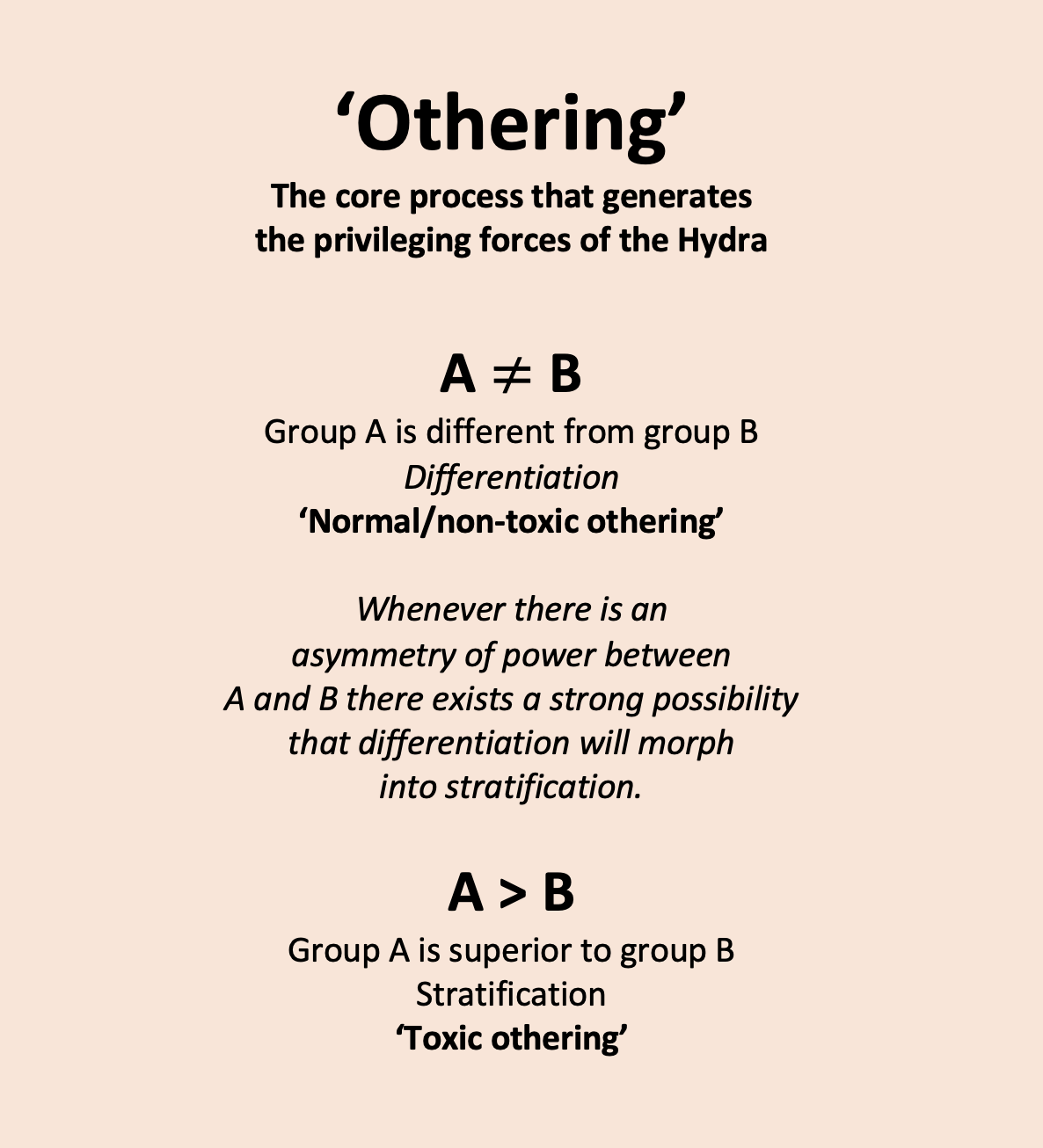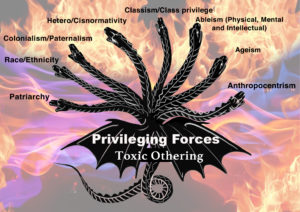[Updated 4-4-23]
“I’ve never understood what’s the point of supporting gay rights and nobody’s else’s rights, you know? Or workers rights but not women’s rights? It’s, I don’t know, illogical.”
-Mark Ashton to Dai in Pride (2014)
Beginning a genealogy of privileging forces: racism, classism, and colonialism/paternalism
Overview
Below is a largely conjectural and theoretical beginning to a conversation about the history of privilege. I build on and then expand the work pioneered by critical race theorists in attempting to describe and explain how false consciousness plays a key role in establishing and maintaining unjust social structures.
Deepening critical Hydra theory
Effectively confronting toxic othering means deepening our use of critical hydra theory (CHT). One way this can be done is by looking at how all of the privileging forces represented by heads of the hydra are embedded into all contemporary cultural structures.
done is by looking at how all of the privileging forces represented by heads of the hydra are embedded into all contemporary cultural structures.
This means looking deeply into our past nationally, regionally, and globally, making attempts to more fully understand the origins of these privileging forces and how they are intertwined in various ways. Critical hydra theory (CHT) builds on critical race theory (CRT) by examining the intersectionality of the many privileging forces and how these are manifested in many policies, practices, norms, and, perhaps most importantly, laws at all levels, local, national, and international.
Important considerations
As I begin this discussion a few points need to be made clear:
- Engaging in a thorough genealogy of privileging forces (the heads of the Hydra) is well beyond the scope of a short essay or, for that matter, even a short book. The level of detail necessary to trace the history of even one privileging force is immense. Below are only the very preliminary thoughts of one academic.
- Driven by mass media and especially social media, our world in many ways is increasingly interconnected politically, economically, legally, linguistically, and culturally to the point that it is not out of the question to talk about a global consciousness. The lines between the local, national and global are blurred as multinational corporations penetrate markets in every corner of our world making a thorough genealogy of privileging forces up to the present a task which demands a keen understanding of the processes driving globalization and how we are becoming one global culture. This is a key point when we apply CHT in an effort to confront toxic othering in any specific context since, quite literally, the fabric of any one culture now includes threads from the growing fabric of our global culture; social structures in any one culture have connections to social structures in multiple other cultures around the globe; everything is connected to everything else, culturally speaking. Addressing any one privileging force in isolation must be done with caution and with an awareness that this isolation is likely an illusion.
- Doing genealogies effectively, especially of privileging forces, means using a variety of written (and oral) sources. An ironic fact is that many sources were/are authored by those with privilege and hence may have inherent bias and thus must be read and employed with caution. The irony that a relatively privileged white male is writing this is noted.
- Perhaps most importantly, doing a thorough genealogy of privileging forces means questioning established power structures and social institutions, i.e., ‘ruffling lots of feathers.’ There is considerable resistance to Critical Race Theory in the United States and this kind of push back can be expected to any critical examination of all privileging forces. Researching, describing, and teaching about privileging forces is both subversive and radical because it means going to the foundations of these social forces and necessarily interrogating and even challenging the status quo.
- Explicitly acknowledging, studying, and learning from the array of data sources used and the research methodologies employed by those engaged in Critical Race Theory (CRT) is critical.
Why ‘genealogy’?
In his books Beyond Good and Evil and On the Genealogy of Morals Friedrich Nietzsche uses the methodology of looking at the roots of words, the origins of their meanings, and how these meanings were reinforced by the words and actions primarily of those in power. Nietzsche argues that many of the moral failings of modern civilization are connected to the efforts of ‘blond beasts of prey’, i.e., the elites controlling power. These books, though he may not have seen it at the time, reinforce a central idea from Marx, namely that “The ideas of the ruling class are, in any age, the ruling ideas”.
Both thinkers are shedding light on the pivotal transition from normal othering to toxic othering, the  universal mechanism underlying all privileging forces. This transition to toxic othering is slow and subtle, and those in power are able to normalize and even glorify the processes and structures that create and support marginalization, using their privileged positions to ossifying these justifications into policies and laws.
universal mechanism underlying all privileging forces. This transition to toxic othering is slow and subtle, and those in power are able to normalize and even glorify the processes and structures that create and support marginalization, using their privileged positions to ossifying these justifications into policies and laws.
Here, a second thought from Marx is very important. He says, “[religion] is the opium of the people.” Religion has been used by those in power to justify and normalize their superior positions long before Marx was writing in the mid-1800s, certainly ever since we adopted an agricultural foundation for human societies over 5,000 years ago. Connecting the dots, religion has been used as a force in maintaining false consciousness in those without power for a very long time. More on that below.
This normalization serves to entrench a false consciousness within both the oppressors and the oppressed. In this case I am taking the liberty to expand Marx’ original and narrow use of this term specifically referencing class differences and the plight of the proletariat. Critical Hydra Theory reframes false consciousness to now include all instances where humans become blinded to the inherent injustices of transitioning from ‘normal othering’ to ‘toxic othering’.
‘Baked-in’ racism
When explaining how racism is structured into our US culture I often use the colloquial phrase that racism is ‘baked into’ our society not only in laws and policies but into the very consciousness of most people. Daniel Quinn in his book Ishmael offers us the term ‘Mother Culture’:
In the way I am using these terms, Mother Culture and false consciousness are interconnected. Mother Culture, for example, whisper’s the lies about the legitimacy of racist ideas and structures and brainwashes the minds of both the oppressor and those oppressed. The oppressed, though, are more facile at deconstructing the lies of Mother Culture and are the first to see through these lies. Most oppressors, benefiting from these lies, from this false consciousness, tend to cling on to these illusions and help to perpetuate the normalization of marginalization.

This illustration with Jesus and a young African-American girl tells an important story and reinforces the idea that we need to be aware of micro-aggressions and how they can (1) be both communicated and received subliminally and (2) tend to accumulate over time to leave a deep impression. That Jesus is portrayed as white by itself is not ‘fatal’, but a steady stream of these kinds of messages can indeed be the ‘thousand cuts’ which act as an oppressive force.
The beginning assumption of critical Hydra theory (CHT) is that all privileging forces have been ‘baked into’ not just the US culture but also all cultures across the globe. A genealogy of privileging forces demands examining (1) how false consciousness(s) developed and were normalized and (2) the deeply complex intersectional and synergistic connections between and among these forces.
It is with a nod to Nietzsche, Marx, and Daniel Quinn that below I begin a discussion about a genealogy of the various privileging forces represented by the heads of the Hydra. Critical to note is that this journey is deeply informed by and builds on the more contemporary work of Paulo Freire, Kimberlé Crenshaw (among the first to develop CRT), Anna Julia Cooper, Patricia Hill Collins, and Audre Lorde.
Whiteness was invented
A recent Guardian article by Robert Baird “The invention of whiteness: the long history of a dangerous idea.” is a good, quick read for those who may be new to this concept. In this essay Baird outlines the history of the concept of race and how it is entwined with other privileging ideas and forces. Much to his credit, it is obvious that Baird listened to and learned from the voices of those most directly affected by structural racism. As I have noted elsewhere, critical Hydra theory must be informed and driven by the voices of those historically marginalized. Baird is certainly not the first writer to make his points but he gives us a very quick and readable summary of the how colonialism, capitalism, and classism all have a part in ‘the invention of whiteness.’
Baird’s core argument is anticipated by commentator Guy Emerson Mount in a 2015 article reviewing Eric William’s very influential 1944 book Capitalism and Slavery. Mount says,
“The thing we call slavery and the thing we call capitalism both continue to provoke scholars with their incestuous relationship (emphasis added).“
Williams is just one of many writers and historians who point out that “slavery was not born of racism: rather, racism was the consequence of slavery.”
In a recorded interview Baird noted,
“Certainly in the United States, whiteness has very often defined itself against blackness. To be white was not to be black. Everyone else was left in between and there was room for tactical accommodations. If you go back to the 1910s and 1920s, you see a series of legal cases that reached the Supreme Court where, in quick succession, you have a Japanese person say ‘well I count as white’ and the Supreme Court says you have to be Caucasian to count as white. Then a person from India sues and says ‘I count as white because I come from Caucasian stock’ and the Supreme Court says ‘no we don’t mean Caucasian in that sense, we mean what an ordinary person would think of as Caucasian.’ You get this circular logic that defines whiteness from the very beginning.”
Though he may be off in his genealogical assertion by a couple centuries, in his essay The Souls of White Folk sociologist WEB Du Bois argues that “The discovery of personal whiteness among the world’s peoples is a very modern thing – a nineteenth and twentieth century matter, indeed.” He is just one of many voices from people of color pointing out the ‘invention of whiteness’ and its impacts. Du Bois does give us a picture of how the idea of whiteness did not appear full blown and universally accepted but rather spread, virus like, slowly and insidiously into the minds of those newly willing to cast themselves as ‘white.’ Mother Culture whispering lies.
In a 2019 article titled “A Global Critical Race and Racism Framework: Racial Entanglements and Deep Malleable Whiteness“ sociologist Michelle Christian expands on the idea that “…the processes of deep and malleable global whiteness that has sustained global white supremacy.” She argues for a Global Critical Race and Racism (GCRR) framework which helps us understand how race and racism have emerged from and been sustained and deepened by colonialism and post-colonial entanglements. She writes,
“…racism is always ‘transforming’ (Goldberg 2009) and ‘on the move’ (Wade 2015), embedded in historical moments, geographies, and other markers of difference while still being entrenched in a continuum of white dominance and racial subordination (Weiner 2012).”
In essence, Christian’s GCRR framework provides support the argument that racism is deeply embedded into global culture and tied to the colonial past. Along these lines it may be useful to think in terms of dividing the world into those nations who were colonizers and those who we colonized, the Global North and Global South, in other words. As globalization has given rise to a world interconnected economically, politically, and culturally, describing the world broken down by the terms Global North and Global North in some cases can be seen as simply code for ‘white’ or ‘non-white’.
But the full story goes back much further.
Proto racism
To be clear, slavery has a long history predating the trans-Atlantic slave trade and still exists today. In terms of raw numbers, there are as many slaves world wide now in 2022 –over 40,000,000– as there were at any time in world history. This is nearly four times more than during the entire period of the trans-Atlantic slave trade era.
Of note is that the justification for slavery in antiquity began as a spoil of war, with this justification changing to racism during the colonization era. Now, in the 21st century, the objectification and commodification of human bodies can be best explained by the simple functioning of an ‘amoral’ global capitalism where anything -or any one- can be commodified and then used to earn a profit and where numerous manifestations of toxic othering based on race, ethnicity, gender, class, and ability allow those responsible to ease their guilt.
Arguments for what has been called ‘proto-racism’ have been made by several researchers. Benjamin Isaac in his essay “Slavery and Proto-racism in Graeco-Roman Antiquity” argues that,
“…prototypes of racism were common in the Graeco-Roman world… In antiquity, as in modern times, we constantly encounter the unquestioned assumption that it is possible and reasonable to relate to entire peoples as if they were a single or collective individual. The conceptual means employed to this end were not the same in antiquity as in modern history, although they are still quite familiar.”
Ethnocentrism -viewing and judging other cultures through the lens of your own culture- has been a human trait since perhaps even before we split from our Proto-human ancestors. Normal othering, as in ‘that other group is not our group’ can lead to toxic othering when there is competition for resources (such as territory or food) and this toxic othering can lead to war and even to genocide. In response to questions about the Gombe Chimpanzee War, noted primatologist Jane Goodall laments that, “We used to think it was only humans that waged war but we find that chimpanzees like humans have this rather unpleasant ability to create an in-group and an out-group.”
In antiquity, as in modern times, we constantly encounter the unquestioned assumption that it is possible and reasonable to generalize about entire groups of peoples, to create ‘out-groups.’ The conceptual and semantic means employed to this end were not the same in antiquity as in modern history, although they are still quite familiar.
It is typical for normal othering to transform into to toxic othering whenever there is an asymmetry of power, with the ‘out-group’ serving as victim. The chances of this transformation happening increase exponentially when there is competition for scare resources. Evidence of inter group conflict leading to extreme toxic othering (i.e., mass deaths) has been found in pre-agricultural human groups as long ago as 10,000 years ago.
Proto racism across the globe set the stage for the forces of capitalism and colonialism to create and then ossify the concepts of race and white supremacy in Western thought. The evil trifecta of racism, classism, and colonialism/paternalism share an intersecting past, each amplifying the other two.
To reemphasize, the transition from normal othering (A≠B therefore A≠B) to toxic othering (A≠B therefore A>B) is essentially an act of ethnocentrism, and ethnocentrism taken to its logical end yields racism. To toxically other is necessarily to dehumanize, to counter anthropomorphize.
Sociological views on the rise of classism
The discussion of ‘proto-racism’ above raises the question of what forces underlie the changing nature of how slavery has been justified. The relationship between slavery and capitalism is key, of course.
I suggest beginning with a broad theoretical approach, looking at cultural evolution and examining how capitalism drove the fundamental restructuring of social life. This restructuring can be seen in the emergence of state societies which, through the actions and example of those in power, legitimized the rise of stratified societies characterized by structured social inequality, beginning the long process of normalizing and then glorifying gluttony and greed. Like the proverbial frog put into a pot of cold water and slowly raising the temperature to boiling and killing the frog, human cultures have accepted the core myth embedded in classism -some ‘deserve’ great power. The slow rate of sociocultural change allowed for this assumption to be steadily perpetuated by those in power, ‘baked into’ norms, policies, laws, and traditions. I don’t think this transition was the result of any one group of leaders but rather an organic process that happened over time as those in power created and sustained the illusion of superiority. Humans invented social stratification -structured social inequality based on power and wealth- and classism just as much later they invented race and ‘whiteness.’
Sociologists view the stages of sociocultural evolution as having a major turning point that occurred between 5,000 and 8,000 years ago. As human cultures transitioned from nomadic and semi-nomadic ways of making a living to agriculture when, for the first time in human history, we had permanent homes. The key to this transition was the higher efficiency of using a plow to till soil using domesticated animals and, simultaneously, ‘domesticating’ various plants, most notably corn, rice, wheat, millet, and barley. This domestication of plants and animals led to the existence of long term stability and, critically, surplus. We could accumulate and store grains, and thus the permanent -and ultimately toxic- transition from Mother Culture whispering egalitarian messages to now ideas and ideologies that justified some having much more than others: classism was born as structured social inequality emerged full blown in agricultural societies. In subsequent stages of sociocultural evolution (industrial, post-industrial, etc.) the messages from Mother Culture remained the same as when they emerged in the first stratified agricultural societies, the only difference is that in early state cultures the leaders were seen as gods or god like (think ancient Egyptian culture and the pharaohs), but in modern cultures the ultra rich and powerful only act as if they were gods. To paraphrase how George Orwell put it in his classic Animal Farm, ‘we’re all equal but some of us are more equal than others.’ The transition from ‘normal othering’ to ‘toxic othering’ relative to classism thus being structurally ‘baked into’ cultures around the globe.
To be clear, the rise of agriculture and state societies (large, permanent settlements) inevitably led to status and power differences. In preagricultural human societies the Hydra existed, but in embryonic form. The toxic Hydra we see today was born again and again all around the world -independently- as the transition to agriculture and hence structured social inequalities happened at locations in Egypt, Mesopotamia, India, China, Mesoamerica, and in the Andes.
“Agriculture led directly to the emergence of hierarchical societies. … Two major consequences of this transition, common to both humans ands social insects, that adopted agriculture, are the subjugation of individuals to the needs of the superorganism and the domination of ecosystems. A third, unique to humans, is the emergence of rigid, hierarchical social systems, dominant castes that are able to exploit humans and nature for their own benefit.“( pgs. 76-77, Ultrasocial)
The broadly accepted lie that some humans are inherently superior to other humans becomes part of Mother Culture. Understanding this rise of false consciousness can be made sense of by employing one of the main theoretical perspectives in sociology, namely symbolic interactionism. This tool can effectively be summarized by the so-called Thomas Theorem which states,
“It is not important whether or not the interpretation is correct — if men define situations as real, they are real in their consequences.”
The key phrase in this theorem is ‘define situations to be real’. In modern vernacular we talk about ‘spin doctors’ who are used to ‘control the narrative’. Telling lies, all the better big lies, is a key weapon of any type of propaganda machine. Here in the United States we are still in the throes of the ‘big lie’ that the 2016 election was ‘stolen’. What happened on January 6th, 2021 is a key testament to the validity of the Thomas Theorem given the consequences of that day are still being felt. We see that those in power have the ability of perpetuate narratives that  serve their needs (see discussions of Rupert Murdock’s media dynasty), and that W. I. Thomas offers an additional theoretical explanation of how (as quoted above from Marx) “The ideas of the ruling class are, in any age, the ruling ideas.”
serve their needs (see discussions of Rupert Murdock’s media dynasty), and that W. I. Thomas offers an additional theoretical explanation of how (as quoted above from Marx) “The ideas of the ruling class are, in any age, the ruling ideas.”
And thus the central wisdom driving a thorough genealogy of all privileging forces is that the truth is what those in power say it is. Normal othering turns into toxic othering but this marginalization is not seen as toxic or pathological but rather as normal and natural. Critical Hydra theory is an examination of how power has been used to normalize and justify the structuring in all of the injustices represented by each head of the Hydra.
See here for a quick overview of colonialism/paternalism.
Beyond racism, classism, and colonialism/paternalism
Although anthropologists are not unanimous on this point, most would argue that the lives of humans before the rise of agriculture, that is 95% of our existence as a species, was marked by an egalitarian life style. Sharing and inclusiveness were strongly reinforced norms in hunting and gathering cultures, and through there was some degree of gender differentiation (women did more of the early childcare and gathering and men did more of the hunting), gender stratification appears non-existent. The mysogny and homophobia found in agricultural societies and in modern cultures was slowly ‘baked’ into these cultures during the rise of agriculture. Similarly, there is ample evidence that those differently abled (mentally, physically, cognitively) were cared for and accepted, just as with those nearing the end of their lives. Respect for the environment and other species is part of the ideologies and cosmologies found in hunting and gathering cultures.
Of note is the fact that agriculture emerged independently in at least six very different parts of the globe, including in the Americas, the Middle East, China, and sub-Saharan Africa. Jarring to note is that these agriculturally-based cultures all ended up in the same place: marked by vast and increasing wealth and power differences, gender stratification, and indeed all manner of toxic othering.
And so we have now hit on each head of the Hydra as we begin exploring a genealogy of these privileging forces. There is much more work to be done, of course. We can’t turn the clock back to our more egalitarian past, but understanding how toxic othering in all its forms came to be in the last 5,000 years can perhaps inform how we best mover forward toward our goal in understanding and then confronting the forces of toxic othering.
As pointed out by the quote from Mark Ashton at the beginning of this post, fighting for one justice means, logically, fighting for justice related to all privileging forces.


 Follow
Follow